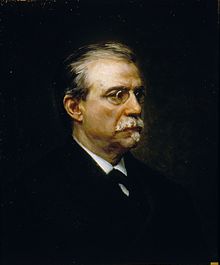Antonio Cánovas del Castillo
|
The Most Excellent Don Antonio Cánovas del Castillo KOGF |
|
|---|---|

Portrait by Ricardo de Madrazo (1896)
|
|
| Prime Minister of Spain | |
|
In office 24 March 1895 – 8 August 1897 |
|
| Monarch | Maria Christina of Austria (regent) |
| Preceded by | Práxedes Mateo Sagasta |
| Succeeded by | Marcelo Azcárraga |
|
In office 8 July 1890 – 13 December 1892 |
|
| Monarch | Maria Christina of Austria (regent) |
| Preceded by | Práxedes Mateo Sagasta |
| Succeeded by | Práxedes Mateo Sagasta |
|
In office 20 January 1884 – 28 November 1885 |
|
| Monarch | Alfonso XII |
| Preceded by | José Posada Herrera |
| Succeeded by | Práxedes Mateo Sagasta |
|
In office 11 December 1879 – 10 February 1881 |
|
| Monarch | Alfonso XII |
| Preceded by | Arsenio Martínez Campos |
| Succeeded by | Práxedes Mateo Sagasta |
|
In office 3 December 1875 – 8 March 1879 |
|
| Monarch | Alfonso XII |
| Preceded by | Joaquín Jovellar |
| Succeeded by | Arsenio Martínez Campos |
|
In office 10 January 1875 – 12 September 1875 |
|
| Monarch | Alfonso XII |
| Preceded by | Práxedes Mateo Sagasta |
| Succeeded by | Joaquín Jovellar |
| President of the Minister-Regency | |
|
In office 31 December 1874 – 10 January 1875 |
|
| President | Himself |
| Preceded by |
|
| Succeeded by |
|
| Personal details | |
| Born |
Antonio Cánovas del Castillo 8 February 1828 Málaga, Spain |
| Died | 8 August 1897 (aged 69) Mondragón, Spain |
| Political party | Conservative Party |
| Religion | Roman Catholicism |
| Signature | |
Antonio Cánovas del Castillo (8 February 1828 – 8 August 1897) was a Spanish politician and historian known principally for serving six terms as Spanish Prime Minister, his role in supporting the restoration of the Bourbon monarchy to the Spanish throne and for his death at the hands of an anarchist, Michele Angiolillo.
Born in Málaga as the son of Antonio Cánovas García and Juana del Castillo y Estébanez, Cánovas moved to Madrid after the death of his father where he lived with his mother's cousin, the writer Serafín Estébanez Calderón. Although he studied law at the University of Madrid, he showed an early interest in politics and Spanish history. His active involvement in politics dates to the 1854 revolution led by the general Leopoldo O'Donell, when he drafted the Manifesto of Manzanares that accompanied the military overthrow of the sitting government, laid out the political goals of the movement, and played a critical role as it attracted the masses' support when the coup seemed to fail. During the final years of Isabel II, he served in a number of posts, including a diplomatic mission to Rome, governor of Cádiz, and director general of local administration. This period of his political career culminated in his being twice made a government minister, first taking the interior portfolio in 1864 and then the overseas territories portfolio in 1865-1866. After the 1868 Glorious Revolution (Revolución Gloriosa), he retired from the government, although he was a strong supporter of the restoration of the Bourbon monarchy during the First Spanish Republic (1873–1874) and as the leader of the conservative minority in the Cortes, he declaimed against universal suffrage and freedom of religion. He also drafted the Manifesto of Sandhurst and prevailed upon Alfonso XII to issue it, just as he had done years previously with O'Donnell.
...
Wikipedia
